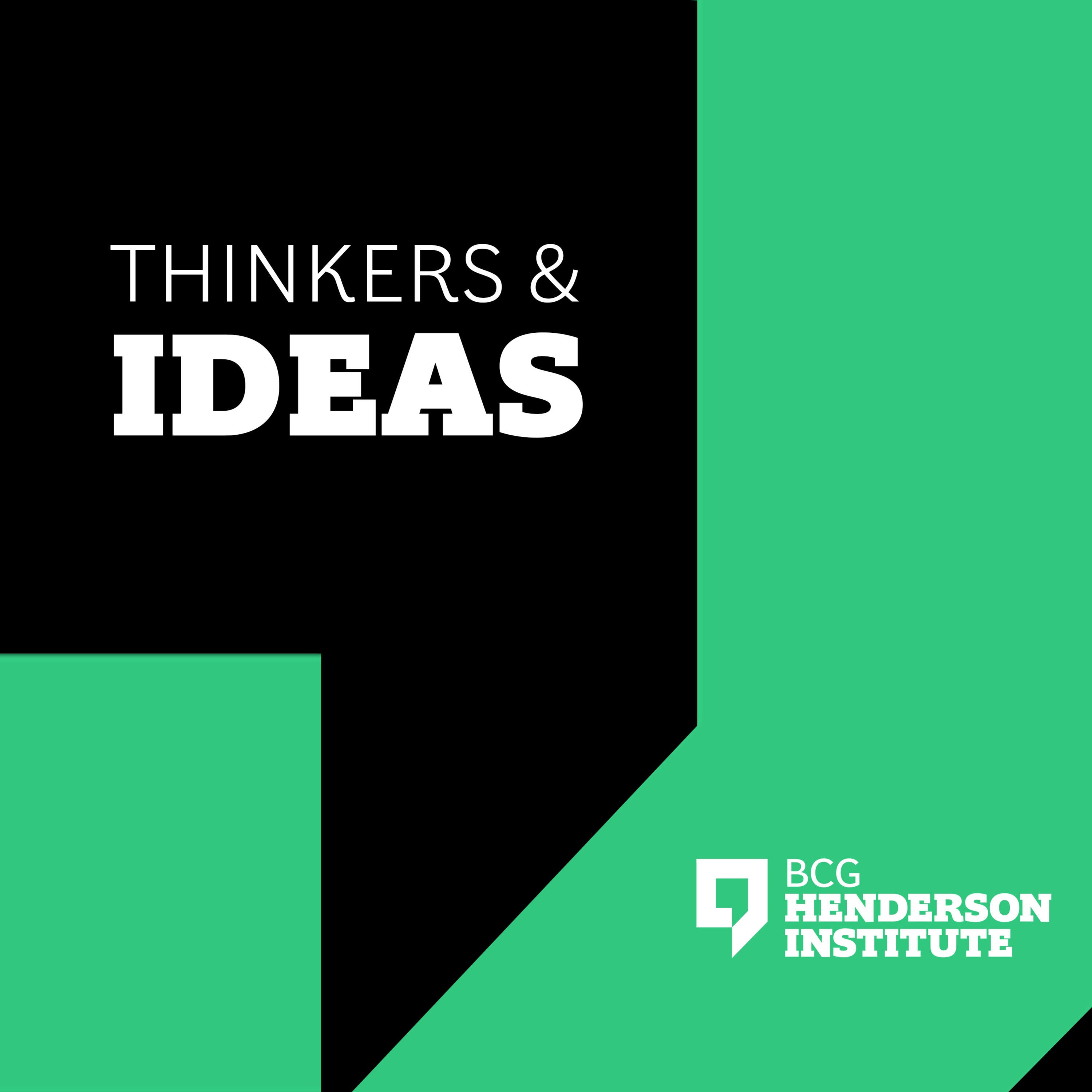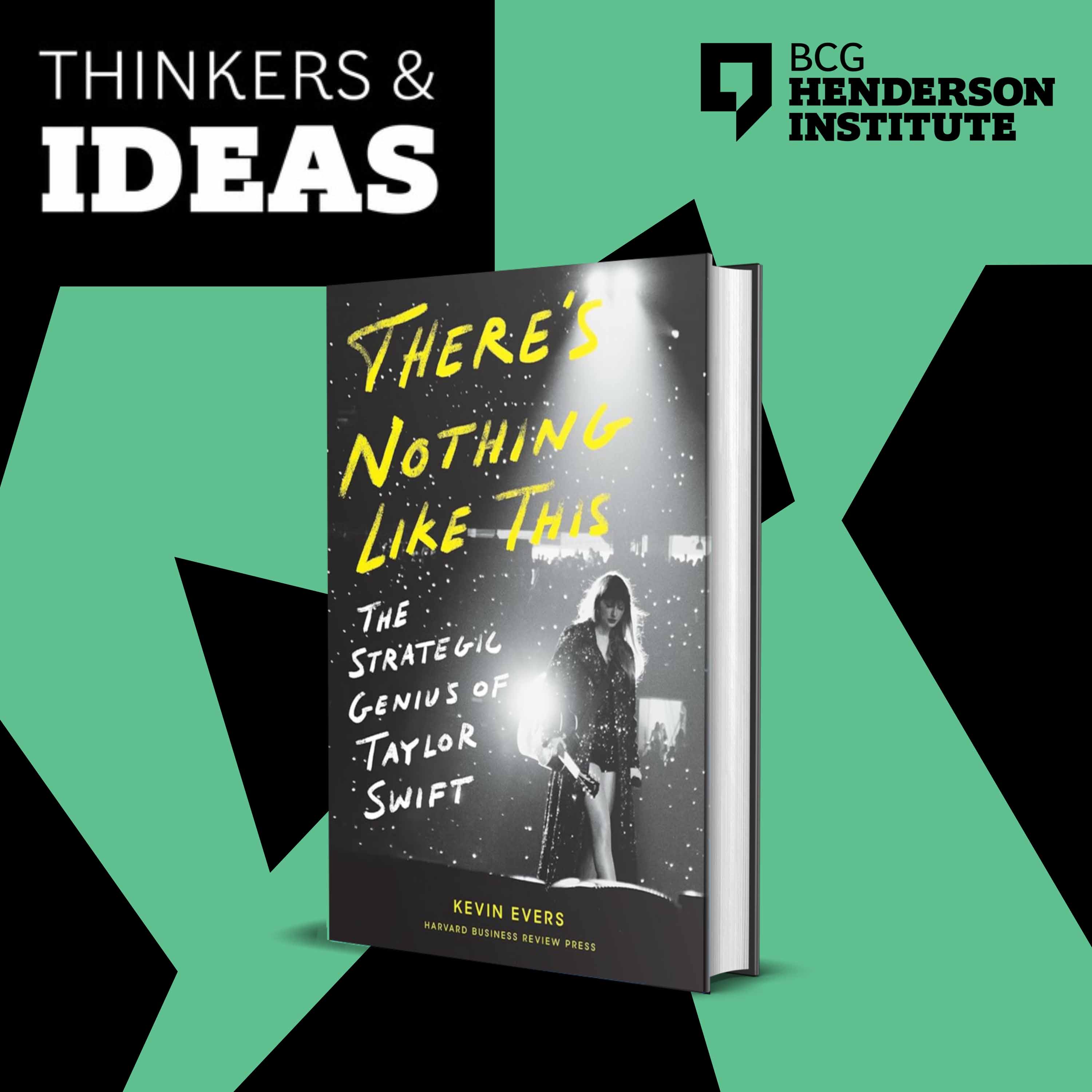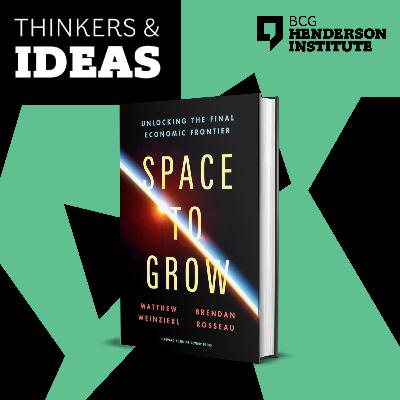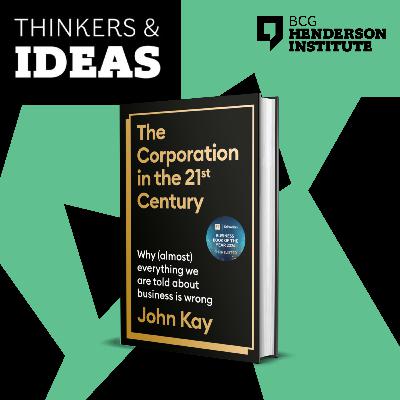Discover Thinkers & Ideas
Thinkers & Ideas

Thinkers & Ideas
Author: BCG Henderson Institute
Subscribed: 295Played: 5,364Subscribe
Share
© Copyright 2025 BCG Henderson Institute
Description
Inspiring and thought-provoking conversations with leading thinkers about influential ideas on business, technology, economics, and science. Hosted by Nikolaus Lang, Martin Reeves, and Philipp Carlsson-Szlezak.
For more ideas and inspiration, sign up to receive BHI INSIGHTS, our monthly newsletter, and follow us on LinkedIn and X.
For more ideas and inspiration, sign up to receive BHI INSIGHTS, our monthly newsletter, and follow us on LinkedIn and X.
131 Episodes
Reverse
In How Progress Ends: Technology, Innovation, and the Fate of Nations, Carl Benedikt Frey argues that progress, throughout history, has not just depended on technological innovations but also on the flexibility of our institutions.Frey is the associate professor of AI & Work at the University of Oxford, where he directs the Future of Work program. In his new book, he explores how technological progress has unfolded throughout history, from the Qin Dynasty to Silicon Valley. He argues that progress is always fragile, resting on achieving a delicate balance between decentralized innovation and centralized scaling of new technologies.In his conversation with Adam Job, senior director at the BCG Henderson Institute, he discusses how to achieve institutional flexibility, the hurdles we must overcome to turn AI into progress, and what lessons history holds for business leaders looking to navigate the conundrum of innovating versus scaling.Key topics discussed: 01:15 | The fragility of progress05:35 | The role of decentralization and centralization11:24 | How to achieve institutional flexibility17:29 | The hurdles to overcome for turning AI into progress21:04 | How business leaders can navigate the conundrum of innovating vs. scaling25:00 | Why progress might not yet endAdditional inspirations from Carl Benedikt Frey:The Technology Trap: Capital, Labor, and Power in the Age of Automation (Princeton University Press, 2019)
In Anointed: The Extraordinary Effects of Social Status in A Winner-Take-Most World, Toby Stuart dives deeply into the power that social status holds over us.Stuart is the Leo Helzel Chair in Entrepreneurship and Innovation at UC Berkeley’s Haas School of Business. In his new book, he explores how social status shapes everything—from who we trust and what we value, to which ideas and innovations change the world and who gets credit for their success.In his conversation with Adam Job, Senior Director at the BCG Henderson Institute, he discusses the cumulative effects of social status, whereby small initial differences can snowball into outsize effects. He also outlines why the social status system persists despite a prevailing distrust in elites—and how AI may yet be poised to change the system.Key topics discussed: 01:44 | The importance of social status05:15 | The role of anointment in modern times13:23 | The cumulative effects of social status19:18 | Why the social status system persists21:23 | How AI may change the role of social status24:45 | The downsides of high social status, and how to deal with them
In Reshuffle: Who Wins When AI Restacks the Knowledge Economy, Sangeet Paul Choudary explores common misconceptions about how AI will change work, organizations, and business ecosystems.Choudary is the founder and CEO of Platformation Labs and a senior fellow at UC Berkeley’s Haas School of Business. An expert on AI, platforms, and the economics of big tech, he has sold more than half a million books on these topics. In his latest work, he explores how new forms of coordination—rather than automation and augmentation—are the true superpower of AI.In his conversation with Adam Job, senior director at the BCG Henderson Institute, he discusses how AI will supercharge coordination, move us towards a more modular, on-demand economy, and how companies can account for all of this in their strategies.Key topics discussed: 01:31 | How AI will impact jobs04:38 | Assessing the value of jobs09:25 | AI’s power to supercharge coordination14:23 | Unlocking “coordination without consensus”19:00 | Moving towards a modular, on-demand economy25:56 | Crafting a strategy for the age of AIAdditional inspirations from Sangeet Choudary:Platform Revolution: How Networked Markets Are Transforming the Economy and How to Make Them Work for You, co-authored by Geoffrey G. Parker and Marshall W. Van Alstyne (W. W. Norton & Company, 2016)Platform Scale: How an Emerging Business Model Helps Startups Build Large Empires with Minimum Investment (Platform Thinking Labs, 2015)
In The Eurasian Century: Hot Wars, Cold Wars, and the Making of the Modern World, Hal Brands illuminates the historical patterns we must understand in order to better navigate the geopolitical rivalries of the present.Hal Brands is the Henry A. Kissinger Distinguished Professor of Global Affairs at the Johns Hopkins School of Advanced International Studies (SAIS). He is also a senior fellow at the American Enterprise Institute and a columnist for Bloomberg Opinion. In his new book, he traces the arc from World War I to today’s rivalries between the United States and China, and between NATO and Russia.In his conversation with Nikolaus Lang, global leader of the BCG Henderson Institute, he discusses why the 20th and 21st centuries are the Eurasian (rather than the American) Era, how today’s rivalries among great powers differ from those of the past, and what global business must pay attention to in navigating current geopolitical tensions.Key topics discussed: 01:28 | The 20th and 21st centuries as the Eurasian era05:32 | The “historic achievement” of the Cold War08:34 | How today’s rivalries among great powers are different13:14 | The future of Eurasia15:59 | How global businesses can operate in a polarized geopolitical world20:13 | Reasons to be optimistic vs. pessimistic about the futureAdditional inspirations from Hal Brands:Danger Zone: The Coming Conflict with China, co-authored by Michael Beckley (W. W. Norton & Company, 2022)The Lessons of Tragedy: Statecraft and World Order, co-authored by Charles Edel (Yale University Press, 2019)The Twilight Struggle: What the Cold War Teaches Us about Great-Power Rivalry Today (Yale University Press, 2019)What Good Is Grand Strategy?: Power and Purpose in American Statecraft from Harry S. Truman to George W. Bush (Cornell University Press, 2014)
In The Measure of Progress: Counting What Really Matters, Dame Diane Coyle argues that traditional measures like GDP no longer capture economic realities.Coyle is the Bennett Professor of Public Policy at the University of Cambridge. She is also the director of the Productivity Institute, a fellow of the Office for National Statistics, and a member of the UK’s Competition Commission. Drawing on her deep expertise, she proposes an alternative framework for measuring productivity that enables better policymaking.In her conversation with Nikolaus Lang, global leader of the BCG Henderson Institute, she discusses the shortcomings of GDP—such as a lack of accounting for immaterial goods or natural capital, alternative measures of progress, and how corporate leaders should rethink their approach to measurement.Key topics discussed: 01:32 | The shortcomings of GDP as a measure of productivity09:14 | The issues of inflated GDP statements11:12 | Alternative measures of productivity and progress13:47 | A time-based approach to measuring productivity16:39 | How productivity measurement works in practice18:57 | Implications for corporate leadersAdditional inspirations from Diane Coyle:Cogs and Monsters: What Economics Is, and What It Should Be (Princeton University Press, 2021)GDP: A Brief but Affectionate History (Princeton University Press, 2015)The Soulful Science: What Economists Really Do and Why It Matters (Princeton University Press, 2009)Sex, Drugs and Economics: An Unconventional Intro to Economics (Texere, 2002)
In Chokepoints: American Power in the Age of Economic Warfare, Edward Fishman argues that the nature of international power has fundamentally shifted from military might to economic statecraft.Fishman is a senior research scholar at Columbia University’s Center on Global Energy Policy and an adjunct professor of International and Public Affairs at Columbia. Previously, he served at the US State Department, leading work on economic sanctions. In his new book, he examines how governments—particularly the US’s—are increasingly using financial tools, regulatory measures, and targeted sanctions to shape international relations, secure strategic advantages, and resolve conflicts.In his conversation with Nikolaus Lang, global leader of the BCG Henderson Institute, he discusses the history of sanctions, how the US came to wield them so powerfully, how diplomatic back channels are navigated in applying them—and what is important for making them effective in enforcing the desired governance changes.Key topics discussed: 02:05 | The history of chokepoints and US dominance over them08:45 | The role of businesses in economic diplomacy12:17 | Navigating diplomatic back channels15:32 | The role of technology and export controls19:45 | Oil price caps as an innovation in sanctions design23:10 | The effectiveness of sanctions in enforcing governance changes27:44 | On the origins of this bookAdditional inspirations from Edward Fishman:Foreign Affairs: How Trump Could Dethrone the Dollar (April 8, 2025)
In There's Nothing Like This: The Strategic Genius of Taylor Swift, Kevin Evers examines the singer-songwriter's remarkable career success from a business strategy perspective.Evers is a senior editor at Harvard Business Review, where he has edited bestselling and award-winning books on high performance, creativity, innovation, digital disruption, marketing, and strategy.In discussion with Martin Reeves, Chairman of the BCG Henderson Institute, they cover the scale and longevity of Swift's success, the strategic moves and innovations that have driven her rise and staying power, her ability to reinvent herself and connect with fans in new ways, and lessons for strategists and companies.
In Space to Grow: Unlocking the Final Economic Frontier, Matthew C. Weinzierl and Brendan Rosseau discuss the discuss the history, the present, and the future of the space economy.Weinzierl is the Joseph and Jacqueline Elbling professor of Business Administration at Harvard Business School and founder of the Economics of Space project at HBS. Rosseau is an Orbital Launch strategy manager at the American space technology company Blue Origin. Together, they provide in-depth academic and practitioner perspectives on the space economy.In their conversation with Nikolaus Lang, global leader of the BCG Henderson Institute, they discuss the central governance vs. market-driven models of the space economy, the geopolitics of space, and whether the first trillionaire will be an asteroid miner.Key topics discussed: 02:03 | The three phases of the space economy05:28 | Central governance vs. market-driven model of the space economy08:23 | Geopolitics of space11:33 | The market structure of the space economy (on Earth)17:14 | Space junk21:03 | Asteroid mining23:47 | How to make space interesting again
In The Corporation in the Twenty-First Century: Why (Almost) Everything We Are Told About Business Is Wrong, John Kay provides a novel perspective on the evolution of the contemporary corporation.One of the UK’s leading economists, Kay is a fellow of St John’s College, Oxford. He was the first dean of Oxford’s Saïd Business School and has held chairs at London Business School, the University of Oxford, and the London School of Economics and director of the Institute for Fiscal Studies.In his conversation with Martin Reeves, chairman of the BCG Henderson Institute, Kay discusses the essence of the modern corporation, the changing relationship of capital and labour, the gap between the our historic concept of the corporation and the current reality and the forces that have and will further shape the corporation including sustainability, geopolitics, and technology.Key topics discussed: 01:56 | The essence of a 21st century corporation05:53 | The changing roles of workers and capital12:26 | Limits to corporate scale16:00 | Forces that will shape the future of corporations sustainability, geopolitics, technology21:50 | The impact of AI on the nature of the corporation24:12 | Implications for managersAdditional inspirations from John Kay:Radical Uncertainty: Decision-Making Beyond the Numbers (W.W. Norton & Company, 2020)The Long and the Short of It: A guide to finance and investment for normally intelligent people who aren’t in the industry (IPS - Profile Books, 2016)Other People's Money: The Real Business of Finance (PublicAffairs, 2015)Obliquity: Why Our Goals Are Best Achieved Indirectly (Profile Books GB, 2011)
In Uncertainty and Enterprise: Venturing Beyond the Known, Amar Bhidé revisits and modernizes the concept of Knightian uncertainty. Introduced more than 100 years ago, the concept offers great potential for better understanding corporate decision-making.A renowned expert on innovation, entrepreneurship, and finance, Bhidé is a professor of Health Policy at the Mailman School of Public Health at Columbia University, as well as a professor emeritus of Business at the Fletcher School of Law and Diplomacy, Tufts University.In his conversation with Martin Reeves, chairman of the BCG Henderson Institute, Bhidé discusses the important distinction between repeated and unique events, the relationship between uncertainty and imagination, how corporations can use persuasive narratives and social routes to navigate the future, and whether AI will help or hinder these practices.Key topics discussed:01:16 | The definition of uncertainty04:49 | The relation between uncertainty and imagination09:32 | The power of corporate routines15:57 | The changing nature of uncertainty17:25 | How AI impacts uncertainty21:02 | Corporate implications22:38 | Implications for business educationAdditional inspirations from Amar Bhidé:A Call for Judgment: Sensible Finance for a Dynamic Economy (Oxford University Press, 2010)The Venturesome Economy: How Innovation Sustains Prosperity in a More Connected World (Princeton University Press, 2008)The Origin and Evolution of New Businesses (Oxford University Press, 2000)Flourishing in an Uncertain World: How Entrepreneurs Overcome Doubts and Disagreements (The Kansas City Public Library Lecture, 2025)
In The M&A Failure Trap: Why Most Mergers and Acquisitions Fail and How the Few Succeed, Baruch Lev and Feng Gu provide a wealth of evidence on the success and failure factors of acquisitions.Lev, professor emeritus of Accounting and Finance at NYU’s Stern School of Business and Gu, professor of Accounting and Law at the State University of New York, have analyzed more than 40,000 acquisitions over the past four decades. This has not only allowed them to understand the reasons why 75% of deals fail but also to develop a scorecard that can help decision-makers assess the likelihood of acquisition success ex ante.In their conversation with Martin Reeves, chairman of the BCG Henderson Institute, Lev and Gu discuss how to measure acquisition success, how to curb overconfidence on the side of the acquirer, and key lessons for CEOs seeking inorganic growth.Key topics discussed:[02:45] How mergers and acquisitions have changed[05:00] Judging the success or failure of acquisitions[08:16] Drivers of acquisition failure[14:41] Patterns of successful acquisitions[17:27] Overconfidence and its causes[19:51] Managerial implications
In Mindmasters: The Data-Driven Science of Predicting and Changing Human Behavior, Sandra Matz explores what our digital footprints reveal about us and how these insights are used to influence our daily decisions.Matz is the David W. Zalaznick Associate Professor of Business at Columbia Business School, where she also serves as co-director of the Center for Advanced Technology and Human Performance. Using her background in psychology and computer science, Matz investigates the intricate connections between our digital and real lives and how these are shaped by technology.In her conversation with Martin Reeves, chairman of the BCG Henderson Institute, Matz discusses the power of psychological profiling, highlights the harms as well as benefits of the personalization it enables, and outlines implications for businesses and regulators, including the possibility of entirely new business models.Key topics discussed: [01:10] Power of psychological profiling[05:05] Scale and impact of big data–based psychological profiling[09:06] Benefits and harms of personalization[16:05] Challenges of regulating profiling and personalization[17:57] Ramifications of the AI-driven content revolution[23:20] Implications for businesses[28:37] How to manage your data footprintAdditional inspirations from Sandra Matz: Psychological Targeting: What Your Digital Footprints Reveal About You (TED Talk, 2019)
In The Unaccountability Machine: Why Big Systems Make Terrible Decisions and How the World Lost Its Mind, Dan Davies examines why companies and governments systematically generate outcomes that everyone involved claims they do not want.Davies is an economist, writer, and former investment banker known for his insightful analysis of finance, corporate governance, and decision-making systems. He has written extensively on topics such as financial fraud, accountability in organizations, and the intersections of economics and management. His latest book combines cybernetics theory and real-world examples to explain how decisions are increasingly made not by accountable individuals, but by systems.In his conversation with Martin Reeves, chairman of the BCG Henderson Institute, Davies describes the pathologies of failing decision-making systems, explains why we tend not to learn from past mistakes, and outlines why he worries that AI might not improve our capability to make decisions unless we carefully redesign decision systems to tap its potential.Key topics discussed: 01:03 | Unintended outcomes generated by decision-making systems07:08 | What we can learn from the theory of cybernetics09:49 | Pathologies of failing information systems11:49 | Why we make the same mistakes again and again14:41 | How AI may impact decision-making16:39 | Steps toward improving our decision-making systemsAdditional inspirations from Dan Davies:The Brompton: Engineering for Change, co-authored by William Butler-Adams (The Experiment, 2022)Lying for Money: How Legendary Frauds Reveal the Workings of the World (Scribner, 2021)Back of Mind (Substack)
In AI Snake Oil: What AI Can Do, What It Can’t, and How to Tell the Difference, Sayash Kapoor and his co-author Arvind Narayanan provide an essential understanding of how AI works and why some applications remain fundamentally beyond its capabilities.Kapoor was included in TIME’s inaugural list of the 100 most influential people in AI. As a researcher at Princeton University’s Center for Information Technology Policy, he examines the societal impacts of AI, with a focus on reproducibility, transparency, and accountability in AI systems. In his new book, he cuts through the hype to help readers discriminate between legitimate and bogus claims for AI technologies and applications.In his conversation with Martin Reeves, chair of the BCG Henderson Institute, Kapoor discusses historical patterns of technology hype, differentiates between the powers and limitations of predictive versus generative AI, and outlines how managers can balance healthy skepticism with embracing the potential of new technologies.Key topics discussed: 01:05 | Examples of AI “snake oil”04:42 | Historical patterns of technology hypeand how AI is different07:26 | Capabilities and exaggerations of predictive AI11:42 | Powers and limitations of generative AI17:11 | Drivers of inflated expectations20:18 | Implications for regulation23:26 | How managers can balance scepticism and embracing new tech24:58 | Future of AI researchAdditional inspirations from Sayash Kapoor:AI Snake Oil (Substack)A Checklist of Eighteen Pitfalls in AI Journalism (UNESCO article, 2022)
In The Age of Outrage: How to Lead in a Polarized World, Karthik Ramanna provides a framework for leaders to navigate outrage—the intense, polarized reactions to perceived social injustices, political stances, and misaligned corporate actions—by addressing root causes, engaging stakeholders, and building resilience.Ramanna, a professor of Business and Public Policy at the University of Oxford’s Blavatnik School of Government, specializes in business-government relations and corporate accountability.In conversation with Martin Reeves, chairman of the BCG Henderson Institute, Ramanna discusses the three causes of outrage (fear of the future, past injustices, and ideologies of othering), common instincts that mislead leaders, and his five-step framework for navigating the age of outrage.Key topics discussed: 01:08 | Managing in the age of outrage4:21 | Three causes of outrage: fear of the future, past injustices, and ideologies of othering5:48 | The five-step framework for navigating the age of outrage19:04 | Instincts which mislead companies into taking the wrong stance or making the wrong analysis20:45 | The impact of “temperate leadership” and leadership attributes25:22 | Key factors impacting the age of outrageAdditional inspirations from Karthik Ramanna:Political Standards: Corporate Interest, Ideology, and Leadership in the Shaping of Accounting Rules for the Market Economy (The University of Chicago Press, 2015)
In The Corporate Life Cycle: Business, Investment, and Management Implications, Aswath Damodaran presents the corporate life cycle as a universal key for demystifying business finance, strategy and company valuation.Damodaran is a professor of Finance at the Stern School of Business at New York University. Known as “the Dean of Valuation,” he has published extensively in academic journals, written many books for students and practitioners, and remains the world’s foremost expert on the subject of corporate valuation. In his latest book, he outlines how corporations age, describes the characteristics of each stage of their life cycle, and discusses implications for managers and investors.In his conversation with Martin Reeves, chairman of the BCG Henderson Institute, Damodaran outlines how to determine where in the life cycle your company is at, what leadership skills and behaviors are required at each stage, and how the distribution of life cycle stages has changed over recent decades.Key topics discussed: 00:56 | The stages of the corporate life cycle02:21 | How to determine your stage in the life cycle03:36 | The importance of acting your age10:06 | Balancing capital allocation across the portfolio11:27 | Leadership skills for different stages in the life cycle16:56 | Creating value at any stage of the life cycle20:21 | How the distribution of life cycle “shapes” is changing22:58 | The art of communicating complex ideas in simple waysAdditional inspirations from Aswath Damodaran:Applied Corporate Finance (Wiley, 2014)Investment Valuation: Tools and Techniques for Determining the Value of Any Asset (Wiley, 2012)Musings on Markets (Blog)
In Big Bet Leadership: Your Transformation Playbook for Winning in the Hyper-Digital Era, John Rossman provides a playbook for becoming an innovation and transformation winner.Rossman was previously an executive at Amazon, responsible for launching their Marketplace business. Now, he is the managing partner of Rossman Partners, advising leading enterprises on large-scale change, and author of the best-selling books The Amazon Way and Think Like Amazon. In his latest book, he examines why high-stakes change efforts fail and how to frame and manage them more effectively. Companies need to think in terms of “big bets,” which will require executives to adopt the right mindset, tactical steps, and leadership habits.In his conversation with Martin Reeves, chairman of the BCG Henderson Institute, Rossman explains why we need to work in prose, not in PowerPoint; how to think big, while betting small; and how to make the critical decisions to “continue, pivot, or kill” a project.Key topics discussed: 01:19 | What makes a “big bet”04:10 | Thinking in outcomes06:49 | Prose over PowerPoint12:51 | Thinking big, but betting small16:21 | Thinking in systems19:21 | How to decide to “continue, pivot, or kill” – and avoid confusion22:45 | Where “big bet” thinking can be appliedAdditional inspirations from John Rossman:The Amazon Way: Amazon's 14 Leadership Principles (Clyde Hill Publishing, 2021)Think Like Amazon: 50 1/2 Ideas to Become a Digital Leader (McGraw Hill, 2019)
In Critical Systems Thinking: A Practitioner's Guide, Michael C. Jackson emphasizes the need for integrating diverse systems methodologies to navigate complexity and uncertainty.Jackson, an emeritus professor of management systems and former dean of the University of Hull Business School, has also served as president of several prominent systems thinking organizations, including the UK Systems Society, the International Federation for Systems Research, and the International Society for the Systems Sciences. His most significant contribution to the field is his development of Critical Systems Thinking (CST), which emphasizes the combined use of different systems approaches to deal with the complexity that leaders face.In a conversation with Martin Reeves, Chairman of the BCG Henderson Institute, Jackson introduces the EPIC process (Explore, Produce, Intervene, and Check), a four-stage, sequential framework to help leaders deploy systems methodologies. Their discussion includes how different systems perspectives can be combined, how theory informs interventions, how organizations are embracing system thinking, barriers to adoption, and the relevance of systems thinking to today’s business environment.Key topics discussed:2:40 | What systems thinking can offer the traditional MBA toolkit5:20 | Systems thinking in contemporary business scenarios6:37 | The EPIC process: Explore, Produce, Intervene, and Check16:52 | Characteristic tools of systems thinking17:34 | The five lenses of systems thinking21:54 | Advancing the agenda of systems thinkingAdditional inspirations from Michael C. Jackson:Systems Thinking: Creative Holism for Managers (John Wiley & Sons, 2023)Systems Approaches to Management (Springer, 2000)Critical Systems Thinking and the Management of Complexity (Wiley, 2019)Creative Problem Solving: Total Systems Intervention (Wiley, 1991)
There is no shortage of technologists touting the promise of AI, but the frontier of AI fervor is a noted philosopher who thinks the economy could double every few months—and that space colonization by self-replicating machines may not be hundreds of years away.Enter Nick Bostrom, who previously authored the 2014 bestseller Superintelligence about the dangers of AI, and now considers what can go right with AI in his new book Deep Utopia. Bostrom was formerly a professor at Oxford University, and currently principal researcher of the Macrostrategy Research Initiative.In this episode, he joins Philipp Carlsson-Szlezak, Chief Economist of BCG, who is skeptical of AI narratives and thinks technology’s economic impact has long-lagged expectations. They discuss different takes on the likely size and speed of AI’s impact on the macroeconomy, and why they disagree about the prospect of tech-driven mass unemployment. Bostrom also explains key themes from Deep Utopia, including stages of utopia, “shallow and deep” redundancy, implications for policy, as well as the unique rhetorical style of the book.Key topics discussed: 01:45 | Is tech jumping ahead or behind schedule?03:24 | Is Deep Utopia really a book about AI or about philosophy?04:39 | Technological unemployment: Real or fallacious10:54 | Taxonomy of utopia13:59 | What about public policy, such as UBI?15:47 | Concept of shallow and deep redundancy18:50 | Concept of “interestingness”21:07 | Rhetorical style of book23:29 | AI regulation and policyAdditional inspirations from Nick Bostrom:Superintelligence: Paths, Dangers, Strategies (Oxford University Press, 2014)
In The Great Disconnect: Hopes and Fears After the Excess of Globalization, Marco Magnani explores the factors that are driving the crisis of globalization we are currently experiencing.Magnani teaches international economics at LUISS University in Rome and Università Cattolica in Milan. Previously, he was a senior research fellow at the Harvard Kennedy School of Government and worked in investment banking for two decades. In his new book, he discusses the history of internationalization and the benefits that modern globalization has brought—as well as the drawbacks that have become increasingly apparent.Together with Martin Reeves, Chairman of the BCG Henderson Institute, Magnani discusses the causes of the increasing global disconnect—beyond U.S.-China tensions. He also lays out four scenarios for how globalization may play out, as well as practical tips for how executives can prepare for these different futures in a time of deep uncertainty.Key topics discussed: 01:19 | The great disconnect04:13 | The benefits and downsides of modern globalization07:21 | Future scenarios for globalization13:28 | What the history of internationalization reveals about where we are heading15:25 | Implications of AI for globalization16:33 | How globalization or de-globalization might play out in practice21:10 | Implications for businessesAdditional inspirations from Marco Magnani:Making the Global Economy Work for Everyone: Lessons of Sustainability from the Tech Revolution and the Pandemic (Palgrave Macmillan, 2022)Creating Economic Growth: Lessons for Europe (Palgrave Macmillan, 2014)






















I see a contradiction between this idea and its name with the briliant theory presented and well articulated by the late Clay Christensen on disruptive innovation where he explains and asserts the innovation as a market creating and growth idea where a part of market whose needs or jobs have been ignore are answered or it brings in some new customers who had never ever used these kind of products. the contradiction relies on names as this one emphasises on non disruption while the old one although emphasising on disruption but it is intended to target some inefficient markets where it invites new customers.